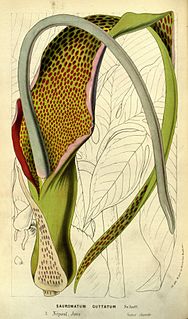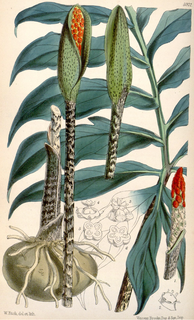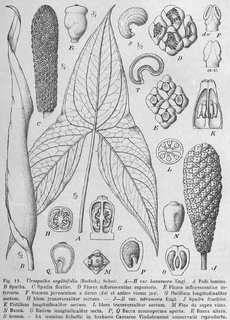
The Araceae are a family of monocotyledonous flowering plants in which flowers are borne on a type of inflorescence called a spadix. The spadix is usually accompanied by, and sometimes partially enclosed in, a spathe or leaf-like bract. Also known as the arum family, members are often colloquially known as aroids. This family of 114 genera and about 3750 known species is most diverse in the New World tropics, although also distributed in the Old World tropics and northern temperate regions.

Monstera is a genus of 45 species of flowering plants in the arum family, Araceae, native to tropical regions of the Americas. The genus is named from the Latin word for "monstrous" or "abnormal", and refers to the unusual leaves with natural holes that members of the genus have.

Peltandra, the arrow arums, is a genus of plants in the family Araceae. It is native to the eastern United States, eastern Canada, and Cuba.
- Peltandra sagittifolia - (Michx.) Morong - Spoon flower or the white arrow arum - southeastern US from eastern Louisiana to Virginia
- Peltandra virginica(L.) Schott - Arum arrow - Cuba, Quebec, Ontario, Oregon, California, Washington; eastern US from Maine to Florida, west to Texas, Kansas, and Minnesota
- †Peltandra primaeva – Eocene, Golden Valley Formation, North Dakota, USA

Sauromatum venosum is a species of plant in the arum family, Araceae. It is native to Asia and Africa, where it grows in forests and riparian meadows.
Areae is an American computer technology corporation located in San Diego, California, that was established in July 2006 by Raph Koster. Areae has been officially changed to Metaplace, Inc. to avoid confusion. Funded by Charles River Ventures and Crescendo Ventures, Areae develops the Metaplace software platform that democratizes the development of virtual worlds.

Schismatoglottis is a genus of flowering plants in the family Araceae. Members of the genus are similar in appearance and growth habit to those of the genus Homalomena, but the two genera are not closely related. The primary difference is that the leaves of Schismatoglottis are not aromatic. Schismatoglottis are found primarily in tropical parts of Southeast Asia, New Guinea, and Melanesia. The majority of the species are native to the Island of Borneo.
- Schismatoglottis acutifoliaEngl. - Borneo
- Schismatoglottis adocetaS.Y.Wong - Sarawak
- Schismatoglottis ahmadiiA.Hay - Borneo
- Schismatoglottis ardeniiA.Hay - Sarawak
- Schismatoglottis asperataEngl. - Borneo
- Schismatoglottis barbataEngl. - Sarawak
- Schismatoglottis bauensisA.Hay & C.Lee - Sarawak
- Schismatoglottis bifasciataEngl. - Borneo
- Schismatoglottis bogneriA.Hay - Luzon, Mindoro
- Schismatoglottis brevicuspisHook.f. - Thailand, Malaysia, Sumatra
- Schismatoglottis calyptrata(Roxb.) Zoll. & Moritzi - Guangxi, Taiwan, Indochina, Philippines, Malaysia, Indonesia, New Guinea, Solomon Islands, Bismarck Archipelago, Vanuatu
- Schismatoglottis canaliculataEngl. - Borneo
- Schismatoglottis ciliataA.Hay - Sarawak
- Schismatoglottis claraeA.Hay - Sarawak
- Schismatoglottis clausulaS.Y.Wong - Sarawak
- Schismatoglottis clemensiorumA.Hay - Sabah
- Schismatoglottis confinisS.Y.Wong & P.C.Boyce - Sarawak
- Schismatoglottis conoideaEngl. - Sarawak
- Schismatoglottis convolvulaP.C.Boyce - Sarawak
- Schismatoglottis corneriA.Hay - Borneo, Anambas
- Schismatoglottis crinitissimaA.Hay - Borneo
- Schismatoglottis cyriaP.C.Boyce - Brunei
- Schismatoglottis decipiensA.Hay - Sabah
- Schismatoglottis dilectaS.Y.Wong, P.C.Boyce & S.L.Low - Sarawak
- Schismatoglottis dulosaS.Y.Wong - Sarawak
- Schismatoglottis ecaudataA.Hay - Sumatra
- Schismatoglottis edanoiA.Hay - Samar in Philippines
- Schismatoglottis elegansA.Hay - Sarawak
- Schismatoglottis erectaM.Hotta - Sarawak
- Schismatoglottis eximiaEngl. - Borneo
- Schismatoglottis eymaeA.Hay - Sulawesi
- Schismatoglottis ferrugineaMerr. - Sabah
- Schismatoglottis gamoandraM.Hotta - Sarawak
- Schismatoglottis gillianiaeP.C.Boyce - Brunei
- Schismatoglottis glaucaEngl. - Borneo
- Schismatoglottis grabowskiiEngl. - Kalimantan Selatan
- Schismatoglottis hainanensisH.Li - Hainan
- Schismatoglottis harmandiiEngl. - Laos
- Schismatoglottis hayanaBogner & P.C.Boyce - Sarawak
- Schismatoglottis hayiS.Y.Wong & P.C.Boyce - Sarawak
- Schismatoglottis hottaeBogner & Nicolson - Brunei
- Schismatoglottis ifugaoensisS.Y.Wong, Bogner & P.C.Boyce - Luzon
- Schismatoglottis incultaKurniawan & P.C.Boyce - Sulawesi
- Schismatoglottis jelandiiP.C.Boyce & S.Y.Wong - Sarawak
- Schismatoglottis jepomiiP.C.Boyce & S.Y.Wong - Sarawak
- Schismatoglottis jitinaeS.Y.Wong - Sarawak
- Schismatoglottis josefiiA.Hay - Sarawak
- Schismatoglottis kurziiHook.f. - Myanmar
- Schismatoglottis lancifoliaHallier f. & Engl. - Borneo
- Schismatoglottis latevaginataEngl. - Borneo
- Schismatoglottis linaeS.Y.Wong - Sarawak
- Schismatoglottis linguaA.Hay - Sabah
- Schismatoglottis longispathaW.Bull - Sarawak
- Schismatoglottis luzonensisEngl. - Philippines
- Schismatoglottis maeliiP.C.Boyce & S.Y.Wong - Sarawak
- Schismatoglottis matangensisS.Y.Wong - Sarawak
- Schismatoglottis mayoanaBogner & M.Hotta - Sarawak
- Schismatoglottis merrilliiEngl. - Luzon
- Schismatoglottis mindanaoanaEngl. - Mindanao
- Schismatoglottis miraS.Y.Wong, P.C.Boyce & S.L.Low - Sarawak
- Schismatoglottis modestaSchott - Kalimantan Tengah
- Schismatoglottis monoplacentaM.Hotta - Sarawak
- Schismatoglottis moodiiA.Hay - Sabah
- Schismatoglottis motleyana(Schott) Engl. - Borneo
- Schismatoglottis multifloraRidl. - Borneo
- Schismatoglottis multinerviaM.Hotta - Sarawak
- Schismatoglottis nervosaRidl. - Sarawak
- Schismatoglottis niahensisA.Hay - Sarawak
- Schismatoglottis nicolsoniiA.Hay - Sarawak
- Schismatoglottis patentinerviaEngl. - Borneo
- Schismatoglottis pectinerviaA.Hay - Brunei
- Schismatoglottis penangensisEngl - Penang
- Schismatoglottis petriA.Hay - Brunei
- Schismatoglottis platystigmaM.Hotta - Brunei
- Schismatoglottis pluriveniaAlderw. - Philippines, Sulawesi
- Schismatoglottis puberulipesAlderw. - Borneo
- Schismatoglottis pudendaA.Hay - Sarawak
- Schismatoglottis pumilaHallier f. ex Engl. - Borneo
- Schismatoglottis pusillaEngl. - Philippines
- Schismatoglottis pyrrhiasA.Hay - Sarawak
- Schismatoglottis retinerviaFurtado - Sabah
- Schismatoglottis roseospathaBogner - Sarawak
- Schismatoglottis samarensisA.Hay - Samar in Philippines
- Schismatoglottis sarikeensis(Bogner & M.Hotta) A.Hay & Bogner - Sarawak
- Schismatoglottis schottiiBogner & Nicolson - Borneo
- Schismatoglottis scortechiniiHook.f. - Peninsular Malaysia
- Schismatoglottis sejunctaA.Hay - Brunei
- Schismatoglottis silamensisA.Hay - Sabah
- Schismatoglottis simoniiS.Y.Wong - Sarawak
- Schismatoglottis subundulata(Zoll. ex Schott) Nicolson - Sulawesi
- Schismatoglottis tahubangensisA.Hay & Hersc. - Sabah
- Schismatoglottis tecturata(Schott) Engl. - Borneo, Riau Islands
- Schismatoglottis tessellataS.Y.Wong - Sarawak
- Schismatoglottis thelephoraS.Y.Wong, P.C.Boyce & S.L.Low - Sarawak
- Schismatoglottis trifasciataEngl. - Borneo
- Schismatoglottis trivittataHallier - Borneo
- Schismatoglottis trusmadiensisA.Hay & Mood - Sabah
- Schismatoglottis turbataS.Y.Wong - Sarawak
- Schismatoglottis ulusarikeiensisS.Y.Wong - Sarawak
- Schismatoglottis unifoliaA.Hay & P.C.Boyce - Sabah
- Schismatoglottis venustaA.Hay - Sabah
- Schismatoglottis viridissimaA.Hay - Sarawak
- Schismatoglottis wahaianaAlderw. - Seram in Maluku
- Schismatoglottis wallichiiHook.f. - Thailand, Malaysia, Borneo, Sumatra
- Schismatoglottis warburgianaEngl. - Sagapan, Mindanao
- Schismatoglottis wongiiA.Hay - Sabah
- Schismatoglottis zonataHallier f. - - Borneo

Asterostigma is a genus of flowering plants in the family Araceae. It is native to Brazil and Argentina. The leaves are pinnate and the plant is tuberous.
- Asterostigma cryptostylumBogner - Brasília, Goiás, Minas Gerais
- Asterostigma cubense(A.Rich.) K.Krause ex Bogner - São Paulo
- Asterostigma lividum(G.Lodd.) Engl. - southern Brazil; Misiones Province of Argentina
- Asterostigma lombardiiE.G.Gonç. - Minas Gerais, Espírito Santo
- Asterostigma luschnathianumSchott - southern Brazil
- Asterostigma reticulatumE.G.Gonç - southern Brazil
- Asterostigma riedelianum(Schott) Kuntze - eastern Brazil
- Asterostigma tweedieanumSchott - Santa Catarina in southern Brazil

Biarum is a genus of flowering plants in the family Araceae. It is composed of plants that are native to the Middle East, southern Europe, and North Africa. Biarum are often found growing in rock crevices and graveled soil composed largely of limestone.

Stylochaeton is a genus of flowering plants in the family Araceae that is endemic to Africa. Stylochaeton are rhizomatous with hastate leaves. Flowering in this genus is said to be quite uncommon. Stylochaeton is the sole genus in the tribe Stylochaetoneae.

Aroideae is a subfamily of flowering plants in the family Araceae. It is the largest subfamily in Araceae and consists of about 72 different genera, and 2,300 species. Many Aroideae have spiny pollen grains without a sporopollenin outer exine layer and lacking an aperture.
Amydrium is a genus of flowering plants in the family Araceae that is native to Southeast Asia, southern China, and New Guinea.
Anadendrum is a genus of flowering plants in the family Araceae. It is native to China and Southeast Asia.

Urospatha is a genus of flowering plants in the family Araceae that consists of approximately 10 known species. They are found growing in South America and Central America in swamps, wet savannahs, and brackish water. The leaves of the species in this genus are upward pointing and sagittate (arrow-shaped). The inflorescences are quite unique; the spathe is mottled and elongated with a spiral twist at the end. The seeds are distributed by water and have a texture similar to cork that allows them to float. They also quickly germinate in water.

Eminium is a genus of flowering plants in the family Araceae. The genus ranges from Turkey and Egypt east to Central Asia. Usually they can be found growing in barren areas in sand or stony soil. The foliage of Eminium resembles Helicodiceros and its inflorescence and fruit resembles those of Biarum.
- Eminium albertii(Regel) Engl. - Turkmenistan, Uzbekistan, Afghanistan
- Eminium heterophyllum(Blume) Schott - Iran, Iraq, Turkey
- Eminium intortum(Banks & Sol.) Kuntze - Turkey, Syria
- Eminium jaegeriBogner & P.C.Boyce - Iran
- Eminium koenenianumLobin & P.C.Boyce - Turkey
- Eminium lehmannii(Bunge) Kuntze - Kazakhstan, Kyrgyzstan, Turkmenistan, Uzbekistan, Afghanistan, Tajikistan
- Eminium rauwolffii(Blume) Schott - Turkey, Syria
- Eminium regeliiVved. - Kazakhstan, Kyrgyzstan, Tajikistan, Uzbekistan
- Eminium spiculatum(Blume) Schott - Egypt, Israel, Palestine, Jordan, Lebanon, Syria, Iraq, Iran

Hapaline is a genus of flowering plants in the family Araceae. It contains 7 species that are found from southern China to Borneo.

Sauromatum is a genus of flowering plants in the family Araceae. The genus is native to tropical Africa, tropical Asia, and the Arabian Peninsula. Their inflorescences last for only a few hours to a day and give off an unpleasant smell. The inflorescence disperses its odor by heating up.
- Sauromatum brevipes(Hook.f.) N.E.Br. - Tibet, Nepal, Bhutan, Assam
- Sauromatum brevipilosum(Hett. & Sizemore) Cusimano & Hett. - Sumatra
- Sauromatum diversifolium(Wall. ex Schott) Cusimano & Hett. - eastern Himalayas, Tibet, Sichuan, Yunnan, Nepal, Bhutan, Assam, Myanmar, Cambodia
- Sauromatum gaoligongenseJ.C.Wang & H.Li - Yunnan
- Sauromatum giganteum(Engl.) Cusimano & Hett. - Anhui, Gansu, Hebei, Henan, Jilin, Liaoning, Shandong, Shanxi, Sichuan, Tibet
- Sauromatum guttatumH. W. Schott - type of the name Sauromatum, Nepal
- Sauromatum hirsutum(S.Y.Hu) Cusimano & Hett. - Yunnan, Laos, Thailand, Vietnam
- Sauromatum horsfieldiiMiq. - Guangxi, Guizhou, Sichuan, Yunnan, Laos, Myanmar, Thailand, Vietnam, Sumatra, Java, Bali
- Sauromatum tentaculatum(Hett.) Cusimano & Hett. - Thailand
- Sauromatum venosum(Dryand. ex Aiton) Kunth - tropical Africa from Ethiopia south to Mozambique and west to Cameroon; Yemen, Saudi Arabia; Indian Subcontinent; Myanmar; Tibet, Yunnan

Spathicarpa is a genus of flowering plants in the family Araceae, all of which are endemic to South America. Spathicarpa species are notable for the fact that the entirety of their spadix is fused to the spathe. The genus is believed to be closely related to Spathantheum. The tribe Spathicarpeae is named after the genus Spathicarpa.

Zomicarpa is a genus of flowering plants in the family Araceae. It is endemic to eastern Brazil.
- Zomicarpa pythonium(Mart.) Schott - eastern Brazil
- Zomicarpa steigerianaMaxim. ex Schott - Bahia















